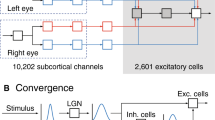Abstract.
This paper presents a learning rule, CBA, to develop oriented receptive fields similar to those founded in cat striate cortex. The inherent complexity of the development of selectivity in visual cortex has led most authors to test their models by using a restricted input environment. Only recently, some learning rules (the PCA and the BCM rules) have been studied in a realistic visual environment. For these rules, which are based upon Hebbian learning, single neuron models have been proposed in order to get a better understanding of their properties and dynamics. These models suffered from unbounded growing of synaptic strength, which is remedied by a normalization process. However, normalization seems biologically implausible, given the non-local nature of this process. A detailed stability analysis of the proposed rule proves that the CBA attains a stable state without any need for normalization. Also, a comparison among the results achieved in different types of visual environments by the PCA, the BCM and the CBA rules is provided. The final results show that the CBA rule is appropriate for studying the biological process of receptive field formation and its application in image processing and artificial vision tasks.
Similar content being viewed by others
References
W. Abraham G. Goddard (1983) ArticleTitleAsymmetric relationships between homosynaptic long-term potentiation and heterosynaptic long-term depression Nature. 305 717–719 Occurrence Handle10.1038/305717a0 Occurrence Handle1983Natur.305..717A
Amari, S., Cichocki, A. and Yang, H.: A new learning algorithm for blind signal separation, In Advances in Neural Information Processing Systems, Vol. 8. MIT Press, pp. 757–763.
A. Artola S. Bröcher W. Singer (1990) ArticleTitleDifferent voltage-dependent threshold for inducing long-term depression and long-term potentiation in slices of rat visual cortex Nature. 347 69–72 Occurrence Handle10.1038/347069a0 Occurrence Handle1990Natur.347...69A
A. Bell T. Sejnowski (1995) ArticleTitleAn information-maximization approach to blind separation and blind deconvolution Neural Comput. 7 IssueID6 1129–1159 Occurrence Handle10.1162/neco.1995.7.6.1129
A. Bell T. Sejnowski (1997) ArticleTitleThe independent components of natural images are edge filters Vision Res. 37 IssueID23 3327–3338 Occurrence Handle10.1016/S0042-6989(97)00121-1
E. Bienenstock L. Cooper P. Munro (1982) ArticleTitleTheory for the development of neuron selectivity: orientation specificity and binocular interaction in visual cortex J.Neurosci. 2 IssueID1 32–48
Blais, B.: The role of the environment in synaptic plasticity: towards an understanding of learning and memory, PhD thesis, Brown University.
D. Hubel T. Wiesel (1962) ArticleTitleReceptive fields, binocular interaction and functional architecture in the cat’s visual cortex J.Physiol. 160 106–154
D. Hubel T. Wiesel (1968) ArticleTitleReceptive fields and functional architecture of monkey striate cortex J.Physiol. 195 215–243
Hyvärinen A. Hoyer P. (2001). Topographic independent component analysis as a model of V1 organization and receptive fields. Neurocomputing 38– 40 , 1307–1315.
C. Law L. Cooper (1994) ArticleTitleFormation of receptive fields according to the BCM theory of synaptic plasiticity in realistic visual environment Proc. Natl Acad. Sci. 91 7797–7801 Occurrence Handle10.1073/pnas.91.16.7797 Occurrence Handle1994PNAS...91.7797L
R. Linsenmeier L. Frishman C. JakielaH. Enroth-Cugell (1982) ArticleTitleReceptive field properties of X and Y cells in the cat retina derived from contrast sensitivity measurements Vision Res. 22 1173–1183 Occurrence Handle10.1016/0042-6989(82)90082-7
R. Linsker (1986) ArticleTitleFrom basic network principles to neural architecture: emergence of orientation-selective cells Proc. Natl Acad. Sci. 83 8390–8394 Occurrence Handle10.1073/pnas.83.21.8390 Occurrence Handle1986PNAS...83.8390L
G. Lynch T. Dunwiddie V. Gribkoff (1977) ArticleTitleHeterosynaptic depression: a postsynaptic correlate of long-term potentiation Nature 266 737–739 Occurrence Handle10.1038/266737a0 Occurrence Handle1977Natur.266..737L
K. Miller (1994) ArticleTitleA model for the development of simple cell receptive fields and the ordered arrangement of orientation columns through activity-dependent competition between on-and off-center inputs J.Neurosci. 14 409–441
K. Miller (1996) ArticleTitleSynaptic economics: competition and cooperation in correlation-based synaptic plasticity Neuron 17 371–374 Occurrence Handle10.1016/S0896-6273(00)80169-5
Neskovic, P. and Verschure, P.: Evaluation of a biologically realistic learning rule, BCM, in an active vision system, In Telluride Workshop on Neuromorphic Engineering.
E. Oja (1982) ArticleTitleA simplified neuron model as a principal component analyzer Math. Biol. 15 267–273 Occurrence Handle0488.92012 Occurrence Handle10.1007/BF00275687 Occurrence Handle684939
T. Sejnowsky (1977) ArticleTitleStoring covariance with nonlinearly interacting neurons J.Math. Biol. 4 303–321 Occurrence Handle10.1007/BF00275079
H. Shouval Y. Liu (1996) ArticleTitlePrincipal component neurons in a realistic visual environment Network. 7 IssueID3 501–515 Occurrence Handle0898.92041 Occurrence Handle10.1088/0954-898X/7/3/003
F. Vico J. Jerez (2003) ArticleTitleStable neural attractors formation: learning rules and network dynamics Neural Process. Lett. 18 1–16 Occurrence Handle10.1023/A:1026258500432
X. Vidyasagar X. Mathukumalli (1993) Nonlinear Systems Analysis Prentice Hall Englewood Cliffs, NJ Occurrence Handle0900.93132
C. Malsburg ParticleVon der (1973) ArticleTitleSelf-organization of orientation sensivity cells in striate cortex Kybernetik. 14 85–100 Occurrence Handle10.1007/BF00288907
L. Zhang J. Mei (2003) ArticleTitleShaping up simple cell’s receptive field of animal vision by ICA and its application in navigation system Neural Networks. 16 609–615 Occurrence Handle10.1016/S0893-6080(03)00133-3
Author information
Authors and Affiliations
Rights and permissions
About this article
Cite this article
Jerez, J.M., Atencia, M. & Vico, F.J. A Learning Rule to Model the Development of Orientation Selectivity in Visual Cortex. Neural Process Lett 21, 1–20 (2005). https://doi.org/10.1007/s11063-004-2023-7
Issue Date:
DOI: https://doi.org/10.1007/s11063-004-2023-7



